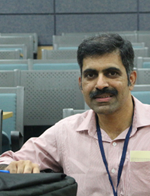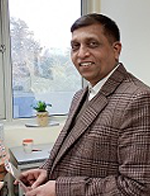थिन फिल्म और टारगेट डेवलपमेंट प्रयोगशाला
यह प्रयोगशाला अंतर-विश्वविद्यालय त्वरक केंद्र के उपयोगकर्ता की सहायक प्रयोगशालाओं में से एक है जो नाभिकीय भौतिकी, परमाणु भौतिकी और सामग्री विज्ञान के क्षेत्रों में त्वरक सुविधाओं का उपयोग करके प्रयोग करने के लिए आवश्यक थिन फिल्मों और लक्ष्यों की तैयारी के लिए उपयोगकर्ता समुदाय को सुविधाएं और आवश्यक सहायता प्रदान करती है। इस प्रयोगशाला में प्रति वर्ष 100 से अधिक पतली फिल्में और लक्ष्य तैयार किए जाते हैं। लक्ष्य की तैयारी के साथ-साथ, प्रयोगशाला 5 माइक्रोग्राम/वर्ग सेमी मोटी, मुक्त-स्थायी कार्बन पन्नी भी तैयार करती है जिसका उपयोग 15यूडी पेलेट्रॉन त्वरक के लिए एक स्ट्रिपर के रूप में किया जाता है। एक वर्ष में पेलेट्रॉन में लगभग 600-800 स्ट्रिपर फॉइल का उपयोग किया जाता है। यह प्रयोगशाला संचरण इलेक्ट्रॉन सूक्ष्मदर्शी (TEM) सुविधा प्रदान करती है।
थिन फिल्म/ टारगेट बनाने की सुविधाएं
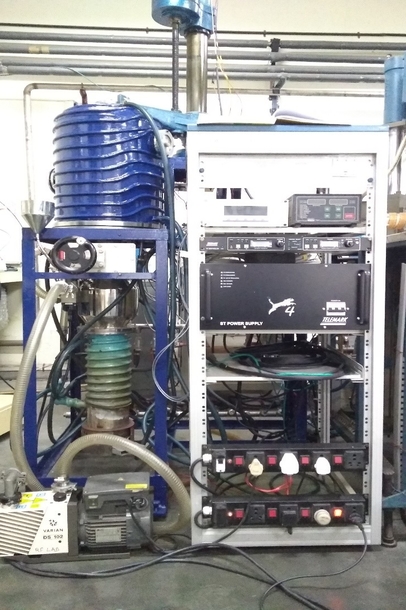
वाष्पीकरणकर्ता-I
विशेषताएँ
- प्रतिरोधी ताप व्यवस्था।
- एक सिंगल पॉकेट इलेक्ट्रॉन बीम गन और 4 किलोवाट बिजली की आपूर्ति।
- क्वार्ट्ज क्रिस्टल मोटाई मॉनिटर।
- तरल नाइट्रोजन जाल के साथ एक प्रसार पंप द्वारा पंप किया गया।
- आधार दबाव ~ 10-7 mbar।
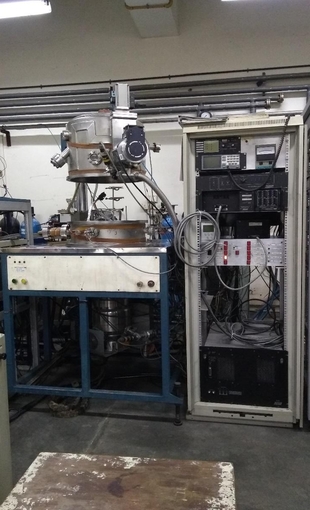
वाष्पीकरणकर्ता-II
विशेषताएँ
- एक 4-पॉकेट इलेक्ट्रॉन बीम गन और 6 किलोवाट बिजली की आपूर्ति।
- 1 एंगस्ट्रॉम की सटीकता के भीतर क्वार्ट्ज क्रिस्टल मोटाई मॉनिटर।
- स्क्रॉल पंप रफिंग के साथ टर्बो-आणविक पंप द्वारा पंप किया गया।
- आधार दबाव ~ 10-7 mbar।
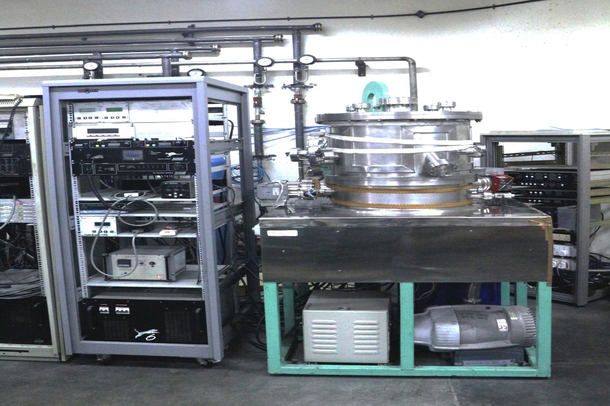
वाष्पीकरणकर्ता-III
विशेषताएँ
- एक 6-पॉकेट इलेक्ट्रॉन बीम गन और 6 किलोवाट बिजली की आपूर्ति।
- 1 एंगस्ट्रॉम की सटीकता के भीतर क्वार्ट्ज क्रिस्टल मोटाई मॉनिटर।
- स्क्रॉल पंप रफिंग के साथ टर्बो-आणविक पंप द्वारा पंप किया गया।
- आधार दबाव ~ 10-7 mbar।
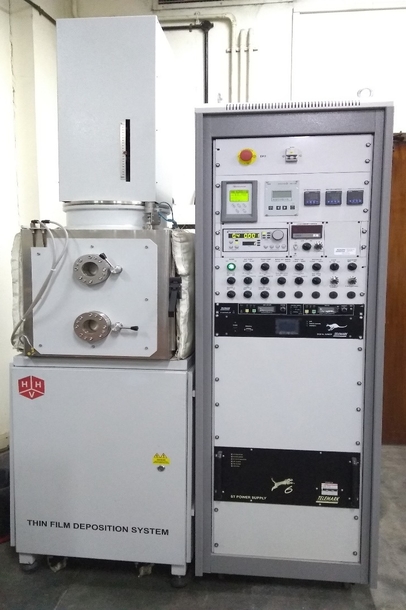
वाष्पीकरणकर्ता-IV
विशेषताएँ
- प्रतिरोधी ताप व्यवस्था।
- एक सिंगल पॉकेट इलेक्ट्रॉन बीम गन और 6 किलोवाट बिजली की आपूर्ति।
- डी के आकार का एक चेम्बर आसानी से साफ करने के लिए
- 1 एगस्ट्रान की सटीकता के भीतर क्वार्ट्ज क्रिस्टल मोटाई मानिटर।
- स्क्रॉल पंप रफिंग के साथ टार्बो आणविक पंप के द्वारा पंप किया गया।
- आधार दबाव ~ 10-7 mbar।
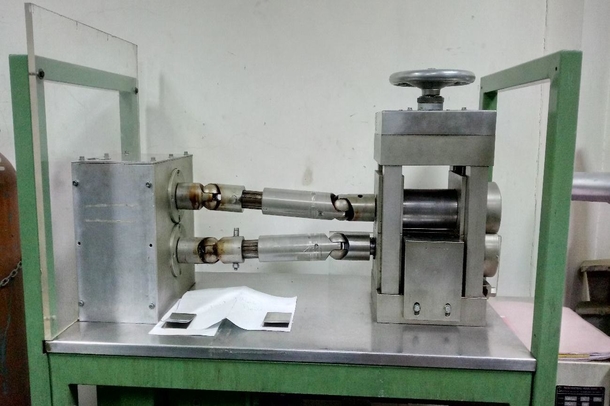
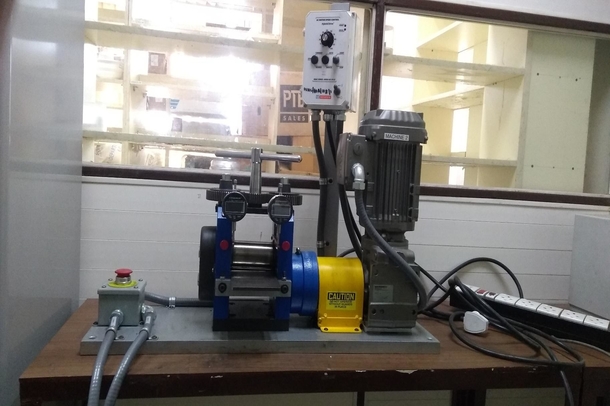
एटम-बीम स्पटरिंग सेटअप
रोलिंग मशीन
- इस मशीन का उपयोग कोल्ड रोलिंग विधि द्वारा पतली पन्नी तैयार करने के लिए किया जाता है।
- लुढ़क जाने वाली सामग्री को दो दर्पण पॉलिश स्टेनलेस स्टील प्लेटों के बीच रखा जाता है और विशेष रूप से कठोर रोलर्स के माध्यम से लुढ़काया जाता है। रोलर्स के बीच का अंतर धीरे-धीरे कम किया जाता है ताकि पतले फोइल प्राप्त किए जा सकें।
- 1 मिग्रा/सेमी2 के क्रम की मोटाई की नमनीय धातुओं की पन्नी इस विधि द्वारा तैयार की जा सकती है।
- बहुत कुशल विधि, कीमती सामग्री की कोई क्षति नहीं।
सूक्ष्म फिल्म मोटाई मापन सुविधाएं
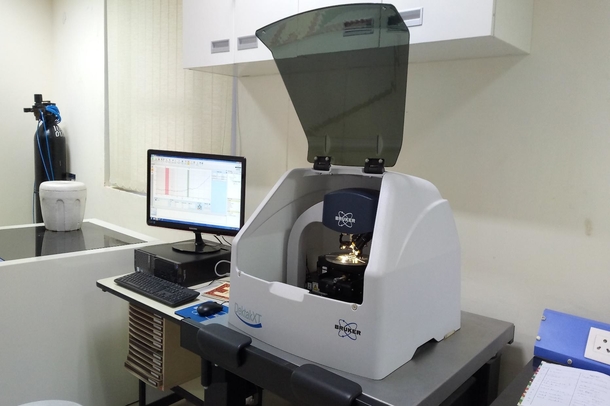
क्वार्ट्ज क्रिस्टल मोटाई मॉनिटर या वजन विधि द्वारा मापी गई मोटाई बहुत सटीक नहीं हो सकती है। पतले की पूर्ण मोटाई मापने के लिए निम्नलिखित विधियों का उपयोग किया जाता है।
स्टाइलस सतह प्रोफाइलर
विशेषताएँ
- कुछ सब्सट्रेट पर जमा की गई पतली परतों की मोटाई को मापने के लिए।
- पतली परत के किनारे पर मौजूद होने के लिए एक कदम की आवश्यकता होती है।
- निर्माण/प्रतिरूपः ब्रुकर-स्टाइलस प्रोफाइलर- DektakXT
अल्फा ऊर्जा हानि लक्ष्य मोटाई मापन सेटअप
पतले मुक्त खड़े पन्नी की मोटाई मापने के लिए, निम्नलिखित विधि का उपयोग किया जाता है। पन्नी की मोटाई कणों द्वारा खोए गए ऊर्जा को मापने और सैद्धांतिक मूल्य के साथ तुलना करके निर्धारित की जाती है।
जिन चरणों का पालन किया जाता है वे इस प्रकार हैं:
- 5.486 मेगा इलेक्ट्रॉन वॉल्ट -241 रेडियोधर्मी स्रोत से अल्फा कणों को पन्नी के माध्यम से गुजारने की अनुमति है।
- कणों का पता एक ठोस अवस्था सतह बाधा डिटेक्टर द्वारा लगाया जाता है।
- स्पेक्ट्रम को एक बहु-चैनल विश्लेषक में दर्ज किया जाता है।
- बहु-चैनल विश्लेषक को ऊर्जा को मापने के लिए कैलिब्रेट किया जाता है।
- उपलब्ध सैद्धांतिक मूल्य से निर्धारित पन्नी सामग्री में 5.486 MeV अल्फा कण का विशिष्ट ऊर्जा क्षति।
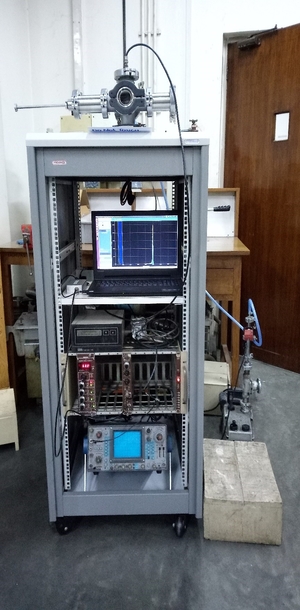
सूक्ष्म संतुलन का उपयोग
मुक्त खड़े पन्नी (विशेष रूप से लुढ़का हुआ पन्नी) के क्षेत्र घनत्व या द्रव्यमान मोटाई का मूल्यांकन एक सटीक सूक्ष्म संतुलन का उपयोग करके पन्नी के वजन को मापने और पन्नी के क्षेत्र से विभाजित करके किया जाता है। सामग्री के घनत्व को जानने से फोइल की मोटाई में परिवर्तित किया जा सकता है।
अन्य सुविधाएँ
सूक्ष्म संतुलन
विशेषताएँ
- 10 माइक्रोग्राम के वजन को सटीकता के साथ मापने के लिए उपयोगी।
- वाष्पीकरण के दौरान खपत सामग्री का मूल्यांकन करने के लिए वाष्पीकरण से पहले और वाष्पीकरण के बाद खपत सामग्री के वजन/क्षेत्रफल को मापने के लिए उपयोग किया जाता है।
- कोल्ड रोलिंग तकनीक का उपयोग करके लक्ष्य की तैयारी के दौरान क्षेत्रीय घनत्व या द्रव्यमान मोटाई को मापने के लिए आवश्यक है।/li>
पेलेट मेकिंग प्रेस
विशेषताएँ
- छर्रों को बनाने के लिए आधा टन प्रेस का उपयोग किया जाता है।
- उचित डाई का उपयोग करके 6 मिमी गोली बनाई जा सकती है। इसका उपयोग गोली के रूप में लक्ष्य की तैयारी के लिए किया जा सकता है।
- इसका उपयोग वाष्पीकरण से पहले पाउडर सामग्री को कॉम्पैक्ट करने के लिए भी किया जाता है।
ट्यूब फर्नेस
विशेषताएँ:
- 900 डिग्री सेल्सियस तक के तापमान पर एनिलिंग
- A 8-रैंप 8-ड्वेल मल्टी प्रोग्रामेबल कंट्रोलर।
- क्वार्ट्ज ट्यूब के अंदर नियंत्रित वातावरण में एनिलिंग ।
रासायनिक निकास और लैमिनार प्रवाह स्वच्छ वायु प्रणाली के साथ ऊर्ध्वाधर रूप से नीचे की ओर लैमिनार प्रवाह
विशेषताएँ:
- पतली-फिल्म वृद्धि से पहले सब्सट्रेट की सफाई और रासायनिक उपचार के लिए।
- कार्यस्थल पर फ़िल्टर की गई हवा प्रवाहित करके स्वच्छ वातावरण बनाता है। रासायनिक निकास भी होता है, जो रासायनिक धुएँ को प्रयोगशाला से बाहर निकालता है।
विद्युत और ऑप्टिकल मापन
रिलीज एजेंट कोटिंग सिस्टम और स्वचालित लक्ष्य फ्लोटिंग सिस्टम
Features
- एजेंट कोटिंग अनुप्रयोगों को जारी करने के लिए समर्पित एक संशोधित स्पिन कोटिंग प्रणाली।
- स्वचालित लक्ष्य फ्लोटिंग अनुप्रयोगों के लिए समर्पित एक संशोधित डिप-कोटिंग प्रणाली।
संचरण इलेक्ट्रॉन सूक्ष्मदर्शी (TEM) सुविधा
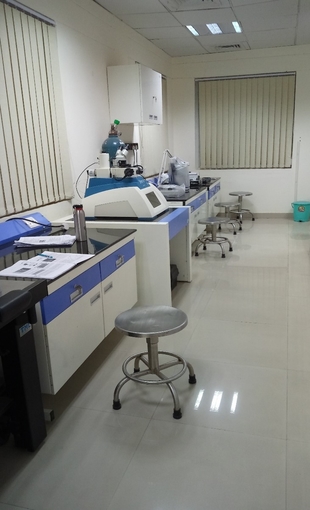
टीईएम नमूना तैयारी
विशेषता:
- यह प्रयोगशाला टीईएम नमूना तैयार करने के लिए हॉट प्लेट, पारंपरिक लैपिंग/ग्राइंडिंग टूल्स, डिंपल ग्राइंडर, डायमंड वायर सॉ और प्रिसिजन आयन पॉलिशिंग सिस्टम (PIPS) से लैस है।
- TEM, क्रॉस-सेक्शनल टीईएम (XTEM) और TEM ग्रिड पर पाउडर के नमूने टीईएम लक्षण वर्णन के लिए यहां तैयार किए जा सकते हैं।
टीईएम सुविधा
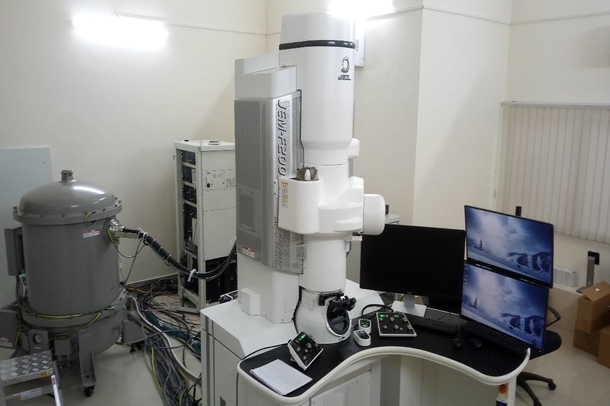
विशेषता:
- निर्माता/मॉडलः JEOL/JEM-F200
- इलेक्ट्रॉन गनः थर्मल इलेक्ट्रॉन फील्ड एमिशन इलेक्ट्रॉन गन (TFEG)
- टीईएम इमेजिंग कैमराः वनव्यू सीएमओएस कैमरा (4kx4k पिक्सल)
- स्कैनिंग टीईएम इमेजिंगः हाई एंगल एनुलर डार्क फील्ड (HAADF)
- एनर्जी डिस्पर्सिव एक्स-रे स्पेक्ट्रोस्कोपी (EDS) JEOL विंडोलेस सिलिकॉन ड्रिफ्ट डिटेक्टर
अद्यतन की तिथि 22/10/2024




